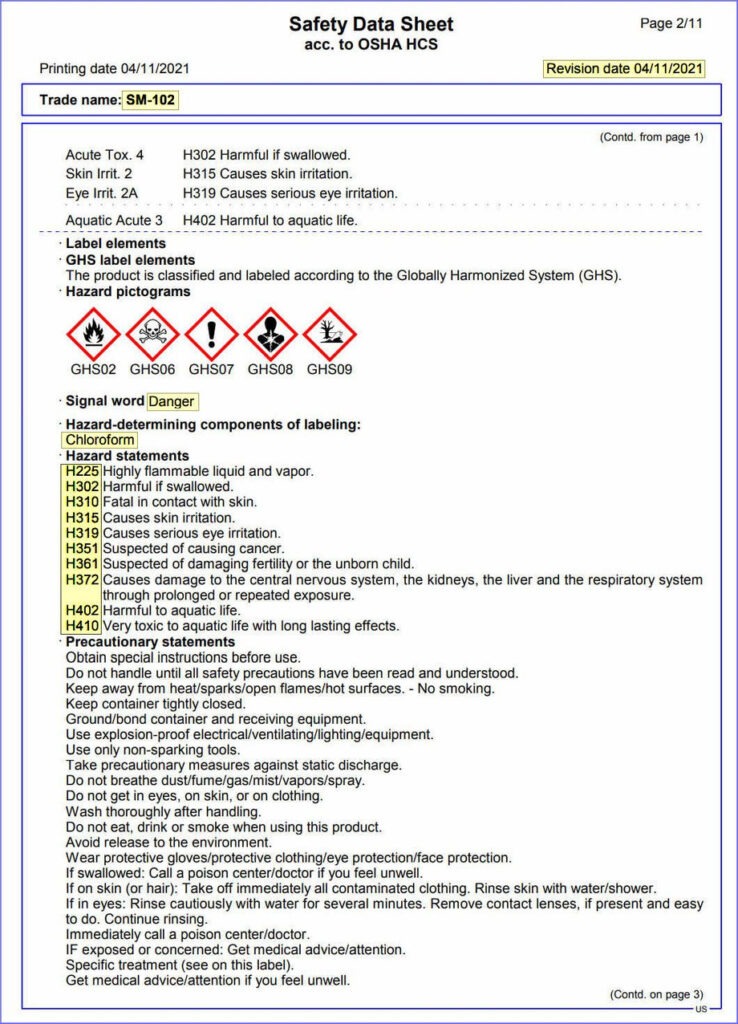by Harold Saive

MAGNETOGENETICS – Engineered Protein Crystals Make Human Cells Magnetic
______________________________________________________________
Compilation of “Magnetgate” Videos Courtesy TIM TRUTH

CAYMAN PRODUCTS – SM-102 Choroform and Luciferase in Delivery of Covid-19 mRNA Vaccines
Product Description
SM-102 is an ionizable amino lipid that has been used in combination with other lipids in the formation of lipid nanoparticles.1 Administration of luciferase mRNA in SM-102-containing lipid nanoparticles induces hepatic luciferase expression in mice. Formulations containing SM-102 have been used in the development of lipid nanoparticles for delivery of mRNA-based vaccines.

______________________________________________________________
MAGNETOGENETICS – Engineered protein crystals make cells magnetic
“Engineering a Genetically Encoded Magnetic Protein Crystal”
9/25/2019: If scientists could give living cells magnetic properties, they could perhaps manipulate cellular activities with external magnetic fields. But previous attempts to magnetize cells by producing iron-containing proteins inside them have resulted in only weak magnetic forces. Now, researchers reporting in ACS’ Nano Letters have engineered genetically encoded protein crystals that can generate magnetic forces many times stronger than those already reported.
Engineered Ferritin for Magnetogenetic Manipulation of Proteins and Organelles Inside Living Cells
ABSTRACT: Magnetogenetics is emerging as a novel approach for remote-controlled manipulation of cellular functions in tissues and organisms with high spatial and temporal resolution. A critical, still challenging issue for these techniques is to conjugate target proteins with magnetic probes that can satisfy multiple colloidal and biofunctional constraints. Here, semisynthetic magnetic nanoparticles are tailored based on human ferritin coupled to monomeric enhanced green fluorescent protein (mEGFP) for magnetic manipulation of proteins inside living cells. This study demonstrates efficient delivery, intracellular stealth properties, and rapid subcellular targeting of those magnetic nanoparticles via GFP–nanobody interactions. By means of magnetic field gradients, rapid spatial reorganization in the cytosol of proteins captured to the nanoparticle surface is achieved. Moreover, exploiting efficient nanoparticle targeting to intracellular membranes, remote-controlled arrest of mitochondrial dynamics using magnetic fields is demonstrated. The studies establish subcellular control of proteins and organelles with unprecedented spatial and temporal resolution, thus opening new prospects for magnetogenetic applications in fundamental cell biology and nanomedicine.
Magnetogenetics: A New Technique For Controlling Mouse Behavior
The endeavor to understand the relationship between observed behaviors and underlying brain activity has important implications for the treatment of many diseases in humans and has thus played a central part in neuroscience. To investigate how the patterns of firing in the brain’s neurons make possible the execution of specific behaviors, it is necessary not only to record brain activity but also to be able to precisely and deliberately manipulate this activity in animal models.
In this article, we will focus on an exciting new paradigm for the manipulation of neural activity: magnetogenetics. We will discuss historical methods for controlling activity in the brains of humans and model organisms, including more traditional techniques such as electrical stimulation, and newer techniques such as optogenetics, before examining in detail how magnetogenetics compares to these, and what experimental evidence exists to validate its use.
SPIONs enable effective delivery of Malaria DNA vaccine (2011)
SUPERPARAMAGNETIC IRON OXIDE NANOPARTICLES (SPIONs)
(Nanowerk Spotlight) Superparamagnetic iron oxide nanoparticles (SPIONs) are emerging as promising candidates for various biomedical applications such as enhanced resolution imaging or targeted drug or gene delivery due to their biocompatibility, low cost of production, ability to immobilize biological materials on their surfaces, and potential for direct targeting using external magnets. Over the past few years, researchers demonstrated that magnetofection is an appropriate tool for rapid and specific gene transfection with low dose in vitro and site-specific in vivo applications.
In new work, scientists in Australia have now successfully demonstrated the use of magnetofection for the delivery of malaria DNA vaccine.
Magnetogenics Goes Deep Into the Brain
The ability to control things with magnetic fields is no longer restricted to the mischief of comic book villains. Using synthetic biology to figure out just what neurons do has always been a tricky task, because it has been limited by requiring invasive surgery (optogenetics) or slow on-off kinetics (drugs). But now magnetogenetics emerges as a new alternative!
Magnetogenetics: remote non-invasive magnetic activation of neuronal activity with a magnetoreceptor
Current neuromodulation techniques such as optogenetics and deep-brain stimulation are transforming basic and translational neuroscience. These two neuromodulation approaches are, however, invasive since surgical implantation of an optical fiber or wire electrode is required. Here, we have invented a non-invasive magnetogenetics that combines the genetic targeting of a magnetoreceptor with remote magnetic stimulation. The non-invasive activation of neurons was achieved by neuronal expression of an exogenous magnetoreceptor, an iron-sulfur cluster assembly protein 1 (Isca1). In HEK-293 cells and cultured hippocampal neurons expressing this magnetoreceptor, application of an external magnetic field resulted in membrane depolarization and calcium influx in a reproducible and reversible manner, as indicated by the ultrasensitive fluorescent calcium indicator GCaMP6s. Moreover, the magnetogenetic control of neuronal activity might be dependent on the direction of the magnetic field and exhibits on-response and off-response patterns for the external magnetic field applied. The activation of this magnetoreceptor can depolarize neurons and elicit trains of action potentials, which can be triggered repetitively with a remote magnetic field in whole-cell patch-clamp recording. In transgenic Caenorhabditis elegans expressing this magnetoreceptor in myo-3-specific muscle cells or mec-4-specific neurons, application of the external magnetic field triggered muscle contraction and withdrawal behavior of the worms, indicative of magnet-dependent activation of muscle cells and touch receptor neurons, respectively. The advantages of magnetogenetics over optogenetics are its exclusive non-invasive, deep penetration, long-term continuous dosing, unlimited accessibility, spatial uniformity and relative safety. Like optogenetics that has gone through decade-long improvements, magnetogenetics, with continuous modification and maturation, will reshape the current landscape of neuromodulation toolboxes and will have a broad range of applications to basic and translational neuroscience as well as other biological sciences. We envision a new age of magnetogenetics is coming.
Possible magneto-mechanical and magneto-thermal mechanisms of ion channel activation in magnetogenetics
Abstract: The palette of tools for perturbation of neural activity is continually expanding. On the forefront of this expansion is magnetogenetics, where ion channels are genetically engineered to be closely coupled to the iron-storage protein ferritin. Initial reports on magnetogenetics have sparked a vigorous debate on the plausibility of physical mechanisms of ion channel activation by means of external magnetic fields. The criticism leveled against magnetogenetics as being physically implausible is based on the specific assumptions about the magnetic spin configurations of iron in ferritin. I consider here a wider range of possible spin configurations of iron in ferritin and the consequences these might have in magnetogenetics. I propose several new magneto-mechanical and magneto-thermal mechanisms of ion channel activation that may clarify some of the mysteries that presently challenge our understanding of the reported biological experiments. Finally, I present some additional puzzles that will require further theoretical and experimental investigation.
Similar articles
-
Barbic M.Elife. 2019 Aug 2;8:e45807. doi: 10.7554/eLife.45807.PMID: 31373554 Free PMC article.
-
Genetically programmed superparamagnetic behavior of mammalian cells.
Kim T, Moore D, Fussenegger M.J Biotechnol. 2012 Dec 31;162(2-3):237-45. doi: 10.1016/j.jbiotec.2012.09.019. Epub 2012 Oct 2.PMID: 23036923 -
Engineered Ferritin for Magnetogenetic Manipulation of Proteins and Organelles Inside Living Cells.
Liße D, Monzel C, Vicario C, Manzi J, Maurin I, Coppey M, Piehler J, Dahan M.Adv Mater. 2017 Nov;29(42). doi: 10.1002/adma.201700189. Epub 2017 Sep 28.PMID: 28960485 -
Ferritin: the protein nanocage and iron biomineral in health and in disease.
Theil EC.Inorg Chem. 2013 Nov 4;52(21):12223-33. doi: 10.1021/ic400484n. Epub 2013 Oct 8.PMID: 24102308 Free PMC article. Review.
Andrews SC.Biochim Biophys Acta. 2010 Aug;1800(8):691-705. doi: 10.1016/j.bbagen.2010.05.010. Epub 2010 May 27.PMID: 20553812 Review.
- 50 U.S. Code § 1520a – Restrictions on use of human subjects for testing of chemical or biological agents
- Pubmed 10/9/2019: Engineering a Genetically Encoded Magnetic Protein Crystal
- Physical limits to magnetogenetics
- Protein crystals for the delivery of biopharmaceuticals
- ‘Magnetofection’ delivers DNA in experimental malaria vaccine (2011)
- Today’s drug-delivery word of the day is “magnetofection,” which essentially is the use of magnetic fields to build up a concentration of magnetic nanoparticles, each containing nucleic acids, and guide them into target cells.
- (Academia.edu) NANOTECHNOLOGY SCIENCE AND TECHNOLOGY SUPERPARAMAGNETIC IRON OXIDE NANOPARTICLES: SYNTHESIS, SURFACE ENGINEERING, CYTOTOXICITY AND BIOMEDICAL APPLICATIONS. (SPIONs)
- Artificial ‘Magneto’ Protein Remotely Controls Brain And Behaviour – Published on May 19, 2021
Researchers in the United States have developed a new method for controlling the brain circuits associated with complex animal behaviours, using genetic engineering to create a magnetised protein that activates specific groups of nerve cells from a distance.
- MAGNETOGENETICS – Is this why magnets are sticking to people’s arms after taking the Covid vaccine?
- Magnetogenetics: A New Technique For Controlling Mouse Behavior
- Magnetogenetics Goes Deep Into the Brain – MARCH 19, 2016
- “The Human Bomb”: Effects of mRNA “Vaccination” on Unvaccinated People?
Genetically engineered ‘Magneto’ protein remotely controls brain and behaviour (Guardian) - Mike444 – Brighteon Video Channel
- Report Claims Covid Test Swabs Packed with Dangerous Hydrogel and Lithium by (Tim Truth)
- Analysis of test sticks from surface testing in the Slovak Republic – confirmation of genocide. (PDF)
- VIDEO: Hugo Talks explains why magnets are sticking to people’s arms were they took the covid-19 jab
- Pfizer Short Title: A Phase 1/2/3 Study to Evaluate the Safety, Tolerability, Immunogenicity, and
Efficacy of RNA Vaccine Candidates Against COVID-19 in Healthy Individuals (PDF) - VIDEO: Covid Test Swabs UP CLOSE: New Report Claims Test Fibers Packed Dangerous DARPA Hydrogel & Lithium (Blood Clots) – Tim Truth
- VIDEO: Bedtime Stories: “Operation Seaspray” – History of Government spraying Cities with toxins
- VIDEO: The Communist Takeover Explained (1966)
- GLOBAL RESEARCH: Frontline Doctors File Temp Restraining Order (TRO) on Vaccinating Children
- TRO DOC: Frontline Doctors File Temp Restraining Order on Vaccinating Children
- TRO DOC PDF: Frontline Doctors File Temp Restraining Order on Vaccinating Children
______________________________________________________________
What Are SPIONs? (Superparamagnetic Iron Oxide Nanoparticles)
Superparamagnetic Iron Oxide Nanoparticle
(Science Direct) Superparamagnetic iron oxide nanoparticles (SPIONs) are a type of MNP (Magnetic nanoparticle) that show magnetic properties in the presence of an external magnetic field. (Like a magnet!)
“Magnetic nanoparticles-based MRI contrast agents show that they can monitor biological process, target them to specific targets in the tissue environment.”
Hypothesis: Migration of spike protein away from the intended injection site in the arm could be due to the presence of SPIONs in the injection that direct the destructive spike proteins into various organs including the arteries, heart, brain, liver, spleen, ovaries and kidneys.
The presence of SPIONs within the patient’s body may be confirmed by applying a magnet to the injection site and other locations on the body where an external magnet will adhere to the skin at the injection site but also at other locations far from the injection site.
A more precise method would be to survey the injection site and other epidermis terrain using a Gaussmeter whereby errors of detection due to weak magnetic attraction and/or the excess weight of various non-standard types of magnets would be less likely. (Source)
Numerous videos demonstrate unexplained magnetism at the vaccination site and other areas of the body including the upper torso, the upper back, arms, neck, nose and cranium.
It should be noted that neither the Moderna or Pfizer product lists SPIONs as an ingredient and may violate the Nuremberg rule of “Informed Consent”.


